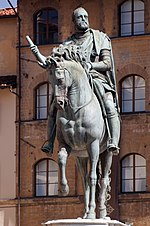Christ and St. Thomas (Verrocchio)

Christ and St. Thomas (1467–1483) is a bronze statue by Andrea del Verrocchio made for one of the 14 niches on the exterior walls of the Orsanmichele in Florence, Italy, where it is now replaced by a cast and the original moved inside the building, which is now a museum. It shows the Incredulity of Thomas, frequently represented in Christian art since at least the 5th century and used to make a variety of theological points. Thomas the Apostle doubted the resurrection of Jesus and had to feel the wounds for himself in order to be convinced (John 20:24–29). The surrounding marble niche was designed by Donatello for his St Louis of Toulouse (1413), but the statue was moved to Santa Croce when the niche was sold to the Tribunale di Mercanzia (merchant's guild), who commissioned the Verrochio work.
Excerpt from the Wikipedia article Christ and St. Thomas (Verrocchio) (License: CC BY-SA 3.0, Authors, Images).Christ and St. Thomas (Verrocchio)
Via dei Lamberti, Florence Quartiere 1
Geographical coordinates (GPS) Address Nearby Places Show on map
Geographical coordinates (GPS)
| Latitude | Longitude |
|---|---|
| N 43.770730555556 ° | E 11.255255555556 ° |
Address
Chiesa di Orsanmichele
Via dei Lamberti
50122 Florence, Quartiere 1
Tuscany, Italy
Open on Google Maps








